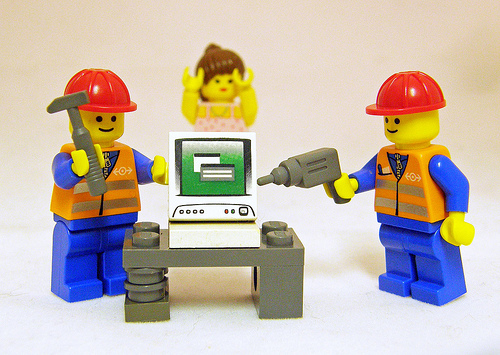
When you pass into what I like to call “complete Evernote madness” and start making it the central hub of your virtual existence, you might find yourself in a bit of a quandary: certainly you have little bits of data that came into existence before you created your Evernote account. The most glaring example of this for me was photos. My oldest child was born almost 3 years before Evernote came out of private beta and let me tell you, everything you’ve heard about the photo-taking habits of first time parents is true. We have about a zillion photos of our son between his birth and now and I’d like to have them in Evernote.
The problem is that when I drag a photo into Evernote, the created date on the note is—quite correctly—the current date. Since I’m building my own history book here, I want my crap to be in chronological freaking order. So, I made a little thing.
I give you, in all its horribly-named glory, EvernoteDatedPhoto.
If your photo was taken on, say, Christmas Day of 2003, there’s a very good possibility the photo itself has that date embedded in it somewhere. When you add an image to Evernote using this app, it will set the “created” date on the note to be the same day the photo was taken. Whiz-bang.
It’s made up of two parts: a short AppleScript saved as a droplet (Apple’s way of saying that you can drag and drop things onto it and it will do something when that happens) and a little Python script. Neither of those little implementation details really matters, though, so we’ll talk about what it actually does and how to use it.
What it actually does
It’s pretty simple, really. When you drag an image file onto this droplet, it grabs the full path to the file and sends that information to the Python script which then reads the image’s Exif data. If this hunk of metadata contains the photo’s creation date, it grabs that information and sends it back to the droplet (it sends back nothing if there’s no date). The droplet then tells Evernote to create a new note with that image file and sets the note’s “created” data to the date that the image was taken. If the image data doesn’t contain the data we want, it just uses the current date when creating the Evernote note.
How to get it and use it
- (Before anything else, you need to have a Mac running OS X 10.6.6 or later as well as Evernote for Mac installed).
- First, download the zip file from Github (where the project is hosted) by going here and clicking the big Downloads button on the right, then clicking “v0.1” under “Download Packages”.
- Save (or move) the zip file somewhere you’ll remember and unzip it. You might also want to rename the folder since its current name is long and ugly.
- Drag the EvernoteDatedPhoto.app icon into your Dock
- Drag an image onto it and make sure it works (it should)
- Open a cold Orange Fanta because that’s it, Fred.
Known Issues and Caveats
- Currently, the app does zero error handling (except some within the Python script). It’s not destructive in any way so it won’t delete any of your data, but you may end up with an errant note or two in your Evernote account.
- It will only accept a single file, not directories or multi-file drops.
- When the note is created in your Evernote account, it uses the default notebook and adds no tags.
- The app will probably crap the bed if you try to drag a file bigger than your Evernote account will allow in a single note (25mb for free users, 50mb for paid).
- This thing uses and includes a third-party library called EXIF.py, a python library that reads EXIF data from images. I didn’t write it, so don’t holler at me if it eats your cat.
I don’t have any immediate plans to fix any of the known issues listed above because, frankly, it works the way I want it to right now. Luckily, this is an open source project on Github, so any of you enterprising young hackers out there who want to do anything with this are cordially invited to fork it and send me pull requests if you do anything cool.
Anyway, I thought all of you Evernote nerds out there might find this useful. If you think this is a cool thing, a mention on Twitter would be pretty sweet :)
Update: thanks to macolyte, we now have folder support! Grab v0.2 from the Downloads section (just like described above)
Photo by Kaptain Kobold


area. you need to be motivated to…
succeed and picking a topic you love can give you that motivation. blogging isn’t something you can just do once before moving on to something else. success relies on updates and ongoing attention. failing to consider your passions can prevent you…